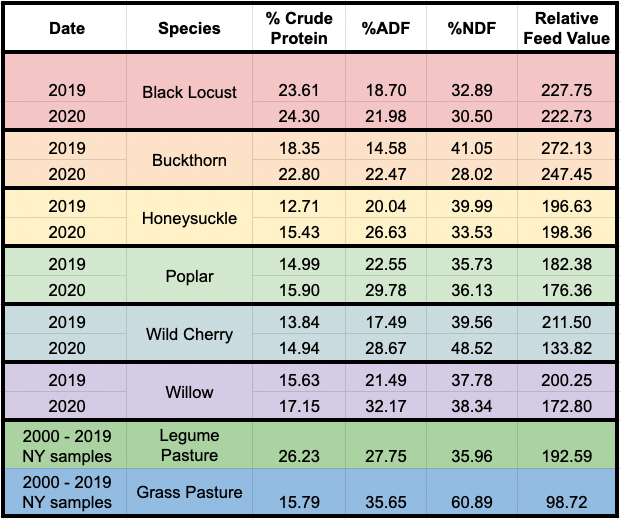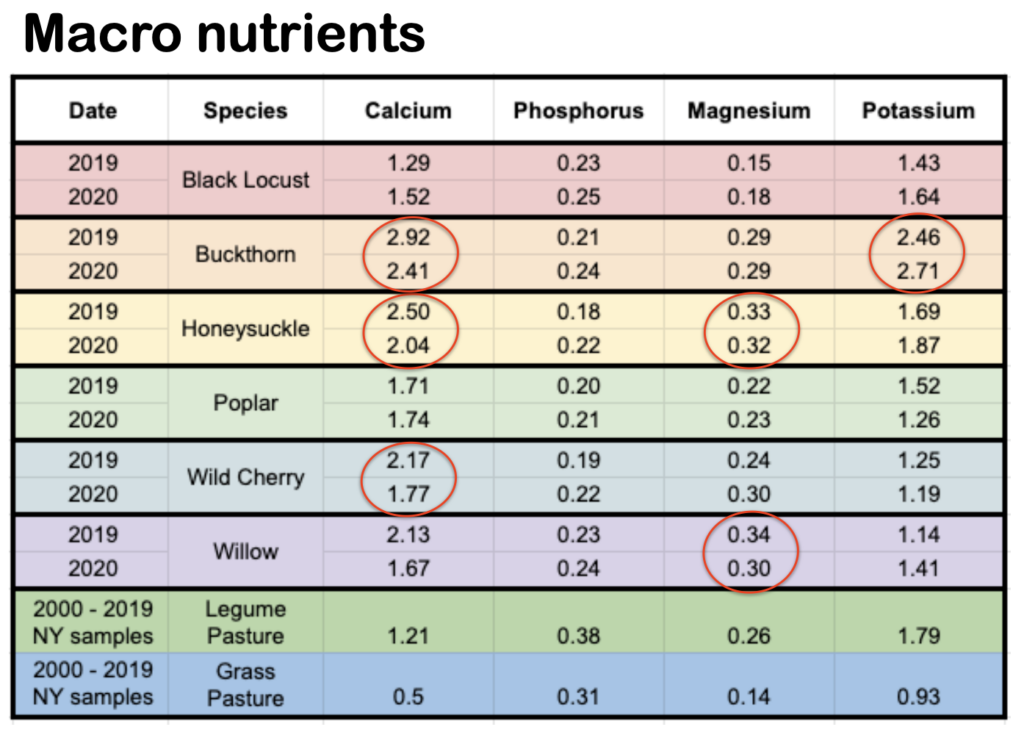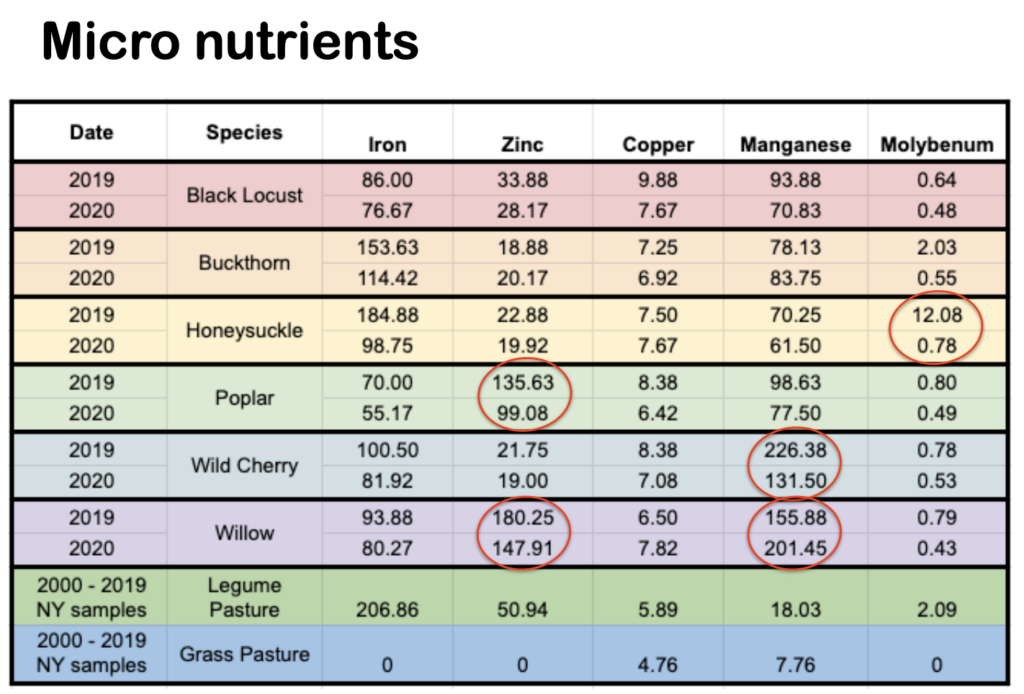Feed values for fodder trees
Hello everyone!
We live in northern Canada, we have Aspen, birch, popular, willows and various wild roses and berry shrubs as well as white and black spruce mainly some pine. What I have been trying to find is a page or paper that lists some of the feed values for fodder tree leaves? Does anyone here have a link like that handy? Thank-you in advance!
Jackie
Tags:
Replies to This Discussion
-
Permalink Reply by Brett Chedzoy on February 11, 2015 at 10:33am
-
If you dig around under the www.agri-dynamics.com website (their page appears to temporarily be down so I can't post the direct link), there's a chart showing the results of some sampling that Jerry Brunetti did some years back of a wide variety of common woody plants and broadleaf herbaceous "weeds". He tested the plants not only for crude protein and digestible fiber, but also for some nutrients like sulfur. In general, the results showed that many woody plants (the soft, edible portions) were quite nutritious and palatable when compared to a quality forage plant like alfalfa.
tatiana Stanton also collected some similar data during Cornell's "Goats in the Woods" study that ended ~ 12 years ago. I don't see a chart in the final report, so will ask her if she can post that here.
Joe Orefice many also have some data from his SARE project in northern NY. Joe?
A few thoughts related to this topic:
- observe what the wildlife (especially, the hooved ungulates) in your area eat - or don't eat. My guess is that the tree species that you list would make pretty good food - especially in the first half of the growing season. The shrubs probably not as much, as they're most likely adapted to be less tasty to wildlife so that they don't get browsed to death. Trees have the ability to outgrow browsing, whereas shrubs do not.
- plant nutritional analysis can usually be done for < $20/sample. Check with a local dairy or crop farmer to see where they send their stuff for testing. Word of caution: just because a sample has good protein and digestibility numbers doesn't mean that animals will readily eat it. The plant could be very high in some elements or compounds that make it taste bad - or even mildly toxic to livestock. An example that comes to mind are the oils in birch (may or may not be an issue - ?). A more expensive, detailed analysis may be justified if you want to see all the "fine details" of just what's in a plant. But the bottom line is will the livestock eat it or not? Two other factors that can affect consumption are: overall diet, and familiarity with the plant. Diet can help - or limit - an animal's ability to tolerate, digest and process plant compounds. Recommend reading up on Fred Provenza's work for some insights into this. it's too complicated for me to understand, so I just try to keep our animals exposed to a diverse grazing smorgasbord and let them figure it out. As for familiarity, take a look at Kathy Voth's website: www.livestockforlandscapes.com I've had the opportunity to hear Kathy present several times and she does a nice job of showing how animals can be trained to eat new things.
- Most browse, like forages, will change in their nutritional values and palatability throughout the growing season. Something that makes good feed in June with new, green leaves may not be nearly as good by September when the leaves are riddled with insect and disease damage and getting ready to drop for the winter.
-
 Permalink Reply by jackie milne on February 11, 2015 at 11:20am
Permalink Reply by jackie milne on February 11, 2015 at 11:20am -
Thank-you very much for your reply Brett!
I will look over everything you have sent me. I understand the points you have made regarding the fresh new growth compared to late summer. Another thing we are thinking to try is to coppice through the aspen/popular forest areas in a thinning fashion to open up the canopy for more sun to get other forbes/grasses to grow in the understory while allowing the new sprouts to be self grazed? Have very many people tired this?
-
Permalink Reply by Brett Chedzoy on May 5, 2020 at 10:34am
-
Shana Hanson in Maine recently shared this report from her study done with help from U of Vermont. The announcement of the study is pasted below, and the referenced report is attached as .pdf.
Tree Leaf Silages and Dried Leaves as Livestock Feed Alternatives
Shana Hanson, 3 Streams Farm, Belfast, ME
A 2019 UVM mini-grant funded nutritional testing of winter-stored tree leaf fodders, the Final Report of which is now posted at link below:
UVM Final Report: Lab Nutritional Analysis of Ensiled Tree Leaves & ... Chipped Leafy Branches...
Lab tested tree leaf fodders included 8 species of chipped leafy branch silages, hand-stripped leaf silages, and dried leaves from tarped leafy branch piles. These fodders were produced as part of SARE FNE18-897, a two-year study which created and described a 1 acre Demo Plot of “air meadow” tree canopy harvest (Figure 2 below), measured yield, labor hours, and goat consumption rate, and recorded cattle, sheep, goat and hog responses to various fresh and stored tree leaf fodders (Figure 3 below).
The stored tree leaf fodders included 8 species of chipped leafy branch silages, hand-stripped leaf silages, and dried leaves from tarped leafy branch piles. These fodders were produced as part of SARE FNE18-897, a two-year study which created a 1 acre Demo Plot of “air meadow” tree canopy harvest plus recorded animal responses to various tree leaf fodders. The SARE FNE18-897 Final Report can be found at:
SARE FNE18-897 Final Report
These white ash, white and yellow birch, red maple, red oak, big-toothed and quaking poplar, and hybrid willow tree leaf fodders were found to have higher Relative Feed Values than grass-based fodders and a rich assortment of minerals, but lower protein availability. Differences in nutrition of chipped versus leaf-only silages, and in ensiled versus dried fodders were examined, and livestock responses from SARE FNE18-897 were juxtaposed with lab data.
Next steps include modification of chipper/shredder equipment to try separation of lighter leaf matter from heavier wood chips, for more densely nutritious silages, and exploration of the acids and life in tree leaf silages, which are very aromatic and palatable, but different than those in grass silage.
Tree leaf based feeds were traditional for many millenia. Layers of foliage can remediate climate disruption. With use of modern equipment and further study, tree leaves have potential to contribute to food- and climate- security today.
- Attachments:
-
 Permalink Reply by jackie milne on May 5, 2020 at 10:39am
Permalink Reply by jackie milne on May 5, 2020 at 10:39am -
Thank you so very much for sharing this update! Extremely helpful right now!
I am going to make a post about you and this info on our small Facebook page, thanks again!
jackie Milne
-
 Permalink Reply by Bryan Clark on March 26, 2022 at 10:03am
Permalink Reply by Bryan Clark on March 26, 2022 at 10:03am -
https://www.feedipedia.org/search/node/Acca%20sellowiana
This website has been a goldmine of information for all sorts of tree/shrub fodder, various crops. It's still in development for many things as they are continuously adding and updating stuff, so if you don't find what you're looking for it may be put in sometime down the road, be patient it's an insanely massive undertaking to get all this data.
-
Permalink Reply by Seva Water on August 9, 2023 at 11:13am
-
Sharing another research update in this thead: Steve Gabriel of Wellspring Forest Farm in NY recently completed a SARE-funded project on the nutritional value of various tree fodders in ruminant grazing systems.
https://projects.sare.org/project-reports/fne19-930/
They looked at:
- Black Locust (Robinia pseudoacacia)
- European Buckthorn (Rhamnus cathartica)
- Honeysuckle (Lonicera japonica)
- Poplar (Populus tremuloides)
- Wild Cherry (Prunus avium)
- Willow (Salix purprea)
""Key findings from this project were:
A. Tree Fodders offer a valuable supplement and emergency food supply for grazing livestock. They are not likely from a management perspective to replace grass and legume forages, but rather offer more nutrient-rich options to a diverge livestock grazing diet.
B. All tree fodders we studied had good relative feed, ADF, and NDF values, indicating they are viable feeds for livestock.
C. Each species brings something different to the table, and not one better than the other. Together they offer a diverse diet to complement grass and legume forages.
D. Macro and micro nutrients are more concentrated in some species versus others, and they flux over the season in complex ways.
E. There were not significant trends or timing deemed critical in feeding these species, as even the lower values were sufficient to meet nutrition needs.
F. Some mineral concentrations are so high there may be some need to have concern with toxicity. In our analysis none of the forages with exceptionally high numbers presented clear toxicity concerns, but is is important to share this as a potential consideration. Feeding fodder in moderation is always recommended.
G. Each species has their own unique profile:
Black Locust is highest valued for its high crude protein content which declines over the season, as well as values for Potassium (little change during the season) and Manganese highest in early July but also spiking in early Sept and Oct, with lowest values of ADF and NDF from early August through early September.
Buckthorn offers a good crude protein content, along with elevated levels of Potassium, Calcium, and Iron, which are highest in the latter end of the season (early October) while NDF and ADF are lowest in September.
Honeysuckle offers a great source of Calcium and Magnesium which is highest toward the end of the season, and Iron which appeared highest in July.
Poplar provides good levels of Calcium, Zinc, and Manganese. While the calcium is greater in the end, the levels of Zine and Manganese appear relatively dispersed through the season, though since its contribution as far a calcium is not as significant as other species.
Wild Cherry’s contributions are Manganese and Calcium, though this foliage doesn’t stand out substantially in comparison with the others, and so it may not matter as much. It’s pretty low value.
Willow is a nutrient sink, offering good values for Calcium, Magnesium, Zinc, and Manganese.
The results give us a compelling reason to continue to develop efficient systems to propagate, plant, manage and feed most of these species in our farm landscape. Forage analysis did prove to help us better understand the benefits, and could be extended to other species we want to learn about, without the need to test so intensively. Testing a new species at the beginning, middle, and end of the season would offer a reasonable snapshot of its feed value.
From a management perspective, the results support our plans to further plant out willow, poplar, and black locust extensively on the farm, species which also meet other objectives within our stewardship goals. We also will continue to manage honeysuckle and buckthorn to reduce their spread but also to provide robust sources of fodder for lean times (drought). ""

-
 Permalink Reply by 3c9cc1cd778846008ec15210a30cea8e on September 25, 2023 at 2:43am
Permalink Reply by 3c9cc1cd778846008ec15210a30cea8e on September 25, 2023 at 2:43am -
It's great to see someone interested in utilizing local foliage for fodder. While I don't have a specific link, you might want to explore local agricultural extension services or reach out to forestry experts in your region. They could provide valuable insights into the feed values of the trees and shrubs you mentioned. Best of luck with your endeavors. g
-
Permalink Reply by Brett Chedzoy on October 2, 2023 at 10:55am
-
An update on Shana's project to mechanize foliage harvesting:
file:///C:/Users/bjc226/AppData/Local/Microsoft/Windows/INetCache/C...
-
Permalink Reply by Seva Water on October 2, 2023 at 11:28am
-
Is there a different link that can be publicly accessed?
Brett Chedzoy said:An update on Shana's project to mechanize foliage harvesting:
file:///C:/Users/bjc226/AppData/Local/Microsoft/Windows/INetCache/C...
-
 Permalink Reply by Shana Hanson on October 31, 2023 at 9:40am
Permalink Reply by Shana Hanson on October 31, 2023 at 9:40am -
That was my 2023 Annual Report for SARE FNE22-013. I am web-incompetent, but I think it can be searched on NESARE, and also has functioning link from the Resource page, or else is pasted into the page you get from the "SARE Grant" tab, both found at my farm website https://3streamsfarmbelfastme.blogspot.com I type looking at the keyboard, and have limited eye-tollerance to check these for you. My phone number is 207 338-3301 Voicemail, if you can suggest any other tree leaf refs, as I am currently typing justification for an extension to SARE FNE22-013 to fund MORE lab analyses.
Brett Chedzoy said:An update on Shana's project to mechanize foliage harvesting:
file:///C:/Users/bjc226/AppData/Local/Microsoft/Windows/INetCache/C...
About
Forum
Hi! Newbie here...
Started by Lolly Winne Clough Jun 18, 2025. 0 Replies 0 Likes
Hello everyone! I'm Lolly and I'm new here. 👋 I was just wondering if there's an organization in Chenango County that will assess your land and assist with a silvopasture plan? I have about 4 acres…Continue
Silvopasture article in Modern Farmer
Started by Brett Chedzoy May 27, 2025. 0 Replies 1 Like
Nice overview of silvopasturinghttps://modernfarmer.com/2025/05/silvopasture/Continue
overwintering sheep in the woods
Started by Gabe Smith. Last reply by Brett Chedzoy Feb 5, 2025. 1 Reply 0 Likes
Is there a reasonable way to manage grazing in the woods during winter or using it as an overwintering site in place of a barn (there is no current barn)? The woods are shruby with multiflora rose,…Continue
river locust anyone grazing animals on it
Started by Jonathan Bates Nov 14, 2024. 0 Replies 1 Like
Wondering what folks experience is with this plant Amorpha fruticosa... Here is a cool video that includes a silvopasture that is utilizing it:…Continue
© 2026 Created by Peter Smallidge.
Powered by
![]()




